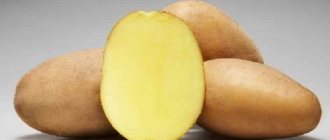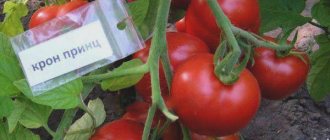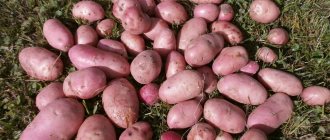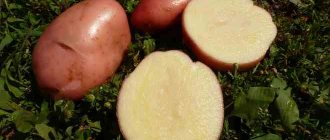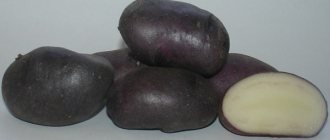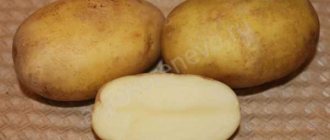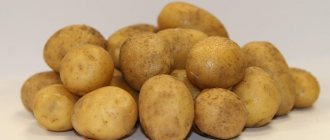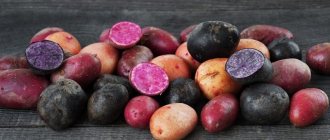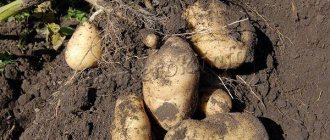Potatoes are rightly called the second bread, since it is impossible to imagine a culinary dish without this vegetable. Although several centuries ago in Russia they refused to grow this crop or eat it. But the situation changed dramatically after another famine. Since then, potatoes have become an indispensable, favorite product. I will try to give a description of the potato varieties that have taken root best in our country. For convenience, they are divided into different classifications.
Favorite vegetable of many Russians
Unpretentious and hardy
2017 was a difficult year for gardeners, since the first months of summer were not pleasant with warm and sunny days, and in May there were generally severe frosts. But it was possible to identify the most unpretentious and hardy varieties of potatoes.
- Mowgli . It is characterized by high productivity, despite all unfavorable conditions.
- Colette . Although the variety is early, it still has good keeping quality.
- Red Fantasy . Tolerates dry seasons well. During cooking, the pulp acquires an oily, delicate consistency.
- Ermak . Tolerates low temperatures. The tubers are large and shaped like flat cakes.
Variety "Colette"
Variety "Red Fantasy"
Diseases and pests
"Sheri" is highly resistant to cyst nematodes and malignant tumors.
The main difficulties during cultivation arise from the action of such aggressors.:
- Late blight. Due to the rapid ripening, late blight occurs quite rarely in this variety. But if the potato still gets sick, it is necessary to treat it with Revus;
- Colorado beetle. In a small area, you can collect the pest manually, but it is important to look under the leaves, where the first and second instar larvae hide. In large gardens, spraying with insecticides will help: Corado, Commander, Apache.
We invite you to familiarize yourself with potato varieties that have different ripening periods:
| Late ripening | Early ripening | Very early | Mid-late | Mid-early |
| Nikulinsky | Borovichok | Forty days | Crane | Yanka |
| Cardinal | Elmundo | Karatop | Sorcerer | Giant |
| Rocco | Felox | Riviera | Mozart | Tuscany |
| Kiwi | Bellarosa | Zhukovsky early | Grenada | Purple Haze |
| Ivan da Marya | Natasha | Farmer | Melody | Openwork |
| Picasso | Ariel | Minerva | Margarita | Santana |
| Asterix | Queen Anne | Veneta | Ramona | Desiree |
| Slav | Arosa | Kiranda | Dolphin | Lady Claire |
Dietary and boiled
Among potato gourmets, dietary and boiled varieties are highly valued. Dietary ones contain little starch, and boiled ones are considered the most delicious.
Among the boiled ones there are:
- Riviera – super early. The pulp is creamy and granular.
- Bellarosa - appeared in the early 2000s. The tubers are round and rough.
- Tiras is an early variety. High-yielding and unpretentious.
As for dietary ones , here are the most popular:
- Healer - contains many minerals: iodine, potassium, magnesium, iron, etc.
- Northern lights . It contains carotenoids and anthocyanins in large quantities. The fruits also contain insulin, which is necessary for diabetics.
- Cornflower . The beneficial substances contained help prevent the development of cataracts and diseases of the cardiovascular system.
The most productive potato varieties for central Russia
Advantages and disadvantages of the variety
Turnip is not demanding in terms of care , which is why many summer residents and farmers choose it. The variety is also valued for its excellent taste. Potatoes do not boil over or fall apart and are suitable for any dish.
Advantages:
- potatoes cook quickly and have a pleasant taste;
- high productivity;
- resistance to most diseases;
- earlier ripening - young tubers can be dug in the first half of summer;
- drought resistance;
- tubers are able to withstand short-term spring frosts without loss of yield.
The disadvantage is that the yield depends on the weather . Unfavorable weather conditions affect the appearance of tubers - many ugly potatoes appear. For summer residents this is not critical, but for a farmer it is difficult to realize such a harvest.
Difference from other varieties
Although repanka belongs to the early varieties, the safety of the harvest is 90%. Other types of early ripening potatoes cannot boast of this.
Potatoes Innovator (turnip), Nikolaev 2021.
What are elite varieties?
Elite potato varieties are high-quality, high-yielding, disease-resistant planting material.
Among the domestic ones there are:
- Irbitsky,
- Gourmet,
- Kamensky,
- Alyona.
The best varieties of foreign selection:
- Evolution,
- Colomba,
- Flamenco,
- Arizona.
Features of elite species:
- To prevent the yield from falling, the planting location is changed every 3 years;
- seeds need to be changed every 5 years;
- have an excellent unique taste;
- from one hundred square meters you can collect up to 1000 kg of tubers;
- root vegetables have a flat, smooth surface.
Variety "Gourmet"
Variety "Evolution"
The best potato varieties
It's time to sum up the 2021 season .
Which varieties turned out to be the most productive and tasty? I think that since you are here, you are one of those who do not want to waste time on experiments and immediately purchase the best, most delicious varieties of seed potatoes, the most productive and disease-resistant.
I will try to indicate all the characteristics of the variety by which you can judge this potato and make a conclusion whether to plant it or not. After the article - reviews from gardeners about different varieties of potatoes. Moreover, the reviews are both good and bad.
We took into account the feedback from gardeners from different regions about potato varieties and selected the main, most common varieties with positive feedback at the end of 2021.
Potato Gala, variety description, photo
Early high-yielding potato variety. The tubers are round-oval in shape, yellow in color, the flesh is yellow or dark yellow, the eyes are small. The ripening period is 75-80 days. The weight of each tuber at maturity is 100-140 grams.
Gala potatoes are valued for the high marketability of tubers, resistance to mechanical damage, excellent taste and keeping quality during winter storage. The variety is resistant to potato nematode, cancer, scab, and moderately resistant to late blight of tops.
When growing this variety, it is recommended to mow the tops 10-12 days before harvesting.
Potato Impala, characteristics of seed potatoes
An early high-yielding variety of white potatoes. Its bush is tall, up to 75 cm, forms 4-5 stems, flowers are white. Impala potato tubers are yellow, oval-shaped, the eyes are small, the skin is smooth, the flesh is light yellow.
The variety is resistant to cancer, potato nematode, susceptible to late blight and rhizoctonia, and is weakly affected by viral diseases and common scab. The period from germination to technical ripeness is 70-75 days.
Impala potatoes are valued for their early ripening, high productivity, marketability and excellent taste of tubers.
Red Scarlet potatoes, photos, reviews
This is an early, very productive potato of Dutch selection. It surpasses many well-known varieties in terms of productivity.
The bush is about 70 cm high, forms 7-8 stems, the flowers are red-violet. The tubers are elongated-oval with a smooth red skin, yellow flesh and small eyes. There are usually 20 or more tubers in a nest, each weighing 80-85 grams.
The Scarlet potato variety is resistant to late blight, cancer, and leaf curl. It tolerates drought well, making it suitable for growing in very hot climates. The ripening period is about 75 days.
When cooked, potatoes of this variety do not fall apart, maintaining the appearance of tubers. It does not darken during cutting, which is typical for many other varieties. Tubers store well in winter.
The Scarlet variety is resistant to the most well-known viral diseases, but weakly resistant to common scab. The variety is sensitive to late blight of tops, but at the same time resistant to late blight of tubers, which is more important.
Potato Tuleyevsky, description of the variety, characteristics
This is a Siberian mid-season variety of large-fruited potatoes bred in Kemerovo. The Tuleevsky variety is valued for its excellent taste; it is believed that it has no equal. It even surpassed the well-known Adretta variety, although it is very similar in appearance. True, Adretta is a little smaller, on average it is the size of a fist. Tuleyevsky potatoes are most suitable for making mashed potatoes, as they are very crumbly.
These potatoes have yellow tubers with beautiful yellow flesh. The variety does not tolerate drought well and loves moist soil. In good conditions, very large tubers grow, but if there is a lack of boron in the soil, they may have voids inside. That is, you need to first experiment with a small amount of planting material. If the soil is not suitable, the potatoes will not be stored well due to the voids inside. The ripening period of this variety is 90-110 days. The bushes are medium-sized, spreading, the flowers are large, white.
The Tuleevsky variety is resistant to potato canker, moderately resistant on tops and moderately susceptible on tubers to the causative agent of late blight, and susceptible to golden potato nematode.
Potatoes Luck, photos, reviews
This is an early variety, the period from germination to harvest is from 60 to 70 days. The bushes of this variety are dense, low, spreading with white flowers.
Luck potato tubers are large, oval-shaped, with small eyes and thin skin. The color of the tubers is creamy brown, the pulp is white with excellent taste, each weight is 90 - 120 grams. The number of tubers in a nest is usually 10 - 15 pieces.
Potatoes of this variety are resistant to mechanical damage, late blight, cancer, rot, wrinkled mosaic, and viral diseases.
Rosara potatoes, variety description, photo
This is an early potato variety, the ripening period is 70-75 days. Rosary bushes are medium-sized, semi-spreading with red-violet flowers. The tubers of this variety are elongated-oval, with thin skin and small eyes. Potatoes are red, but yellow when cut. These are very tasty potatoes. Each mature tuber weighs 80-115 grams, their number in the nest is up to 18 pieces.
Harvest and storage
Harvesting is the most enjoyable part of the job. But in order to preserve potatoes for as long as possible, you need to prepare and take into account some nuances.
How and when to collect
You need to start collecting at the end of August or beginning of September , you shouldn’t delay it any longer. The weather patterns in the region at this time should be taken into account. If it rains, there is a risk of losing a significant part of the crop.
A week before the expected digging, the tops are cut off . The tubers will have time to grow and accumulate useful microelements.
The dug up potatoes are dried directly on the beds or spread out under a canopy . After a week, the tubers are ready for storage.
Storage features and keeping quality of the variety
Store harvested potatoes in bags or boxes. A cellar, insulated shed or glazed balcony are suitable for storage . Before sending them to the prepared container, the potatoes are sorted. Damaged tubers are put aside and it is advisable to consume them quickly.
Important! Future planting material is stored separately from potatoes intended for food.
Tips for growing rough potatoes
Potato seeds are renewed every four years. Otherwise, the sowing becomes of less quality, the yield decreases, and the root crops are removed. Plants and seed material become infected and lose their resistance to weather conditions and pests.
Areas with frequent rains and heavy dew are at risk of late blight. In a humid climate zone it is better to plant varieties: Sparta, Saturna, Saratov. Pests do not like tubers with thick skins. Red-skinned varieties are suitable for areas where chafer larvae are more common. The golden nematode does not affect Pirol, Sparta. Before storing for the winter, the tubers are well dried.
Potatoes with rough skin are a universal option for household and industrial use. The vegetable has excellent taste in all possible preparations, and the variety of varieties allows you to choose the best option for your own preferences. Growing, storing and transporting root crops will also not be a problem.
There are about four thousand varieties of potatoes in the world. Every year this number increases. World selection is moving forward, and new species are appearing that are more resistant to diseases and are able to bear fruit well under unfavorable environmental conditions.
Potato Vitara - characteristics and description
At the end of the 20th century, German scientists, using selective breeding, developed a new potato variety, Vitara, which is also called Vineta (some sources use the name Veneta). The tubers were brought to Russia in 2002 for the first harvest.
Potato Vitara
Description of the plant
Vitara's fruits are oval or slightly round in shape, depending on the soil in which they grow. The mesh and smooth skin of the root vegetable is often yellowish in color, sometimes light brown.
Features of planting and growing
This variety is not cultivated on an industrial scale . The cultivation is carried out by small farmers and gardeners. Planting and further care of Repanka are not particularly different from similar procedures with other varieties.
Preparing for landing
Medium-sized potatoes are selected for planting . It is not recommended to take tubers that are ugly, damaged, or with rot. You can have a small one - it’s difficult to sell it. Such tubers do not degenerate and produce a good harvest.
Advice. Don't cut the potatoes. This saving of planting material reduces the quality of the harvest.
intended for planting are treated with a growth stimulant in early spring . After drying, lay them out in the light so that they begin to germinate.
Soil requirements
Turnip feels good in almost any soil . And even better - in fertile black soil. If you grow potatoes in heavy loamy soils, there is a high risk of blackleg infection. Productivity also depends on soil preparation.
Attention! Before planting, you need to remove the remains of last year’s plants and treat the soil with a disinfectant.
To prevent infection of bushes and to increase productivity, it is not recommended to plant potatoes in the same place. Ideally, carrots, cabbage, legumes or radishes have previously grown in the selected area.
Dates, scheme and rules of planting
start planting tubers in the ground from the second half of April, based on the climatic characteristics of the region . If spring is early and warm, April planting will be ideal. If spring frosts often occur in the region, it is better to delay planting until early May. In arid areas, on the contrary, you should not delay planting.
Reference. After planting, the temperature should not drop below +10...+12°C. If the soil is too cold, the tubers will freeze and begin to rot.
The optimal distance between bushes is 30-35 cm. Before planting planting material, it is recommended to put wood ash or humus in the holes.
Features of cultivation
During the growing process, standard agricultural technology is used . No additional procedures are required to obtain the harvest.
Turnip does not require special care. It is necessary to perform basic tasks: timely destruction of weeds, regular watering and fertilizing.
Watering mode
The variety is resistant to drought. During the season, 2-3 organized waterings are sufficient - during the period of flowering and tuber formation. If the summer is too hot and dry, you can build a drip irrigation system on the site.
Watering potatoes
Top dressing
For the entire season, two applications of mullein are enough : take 1 liter of fresh manure per 10 liters of water, stir and wait for fermentation. You can replace it with a chemical fertilizer, for example, ammonium nitrate (20 g of substance per 10 liters of water) or potassium phosphate complex (25 g of substance per 10 liters of water). The resulting mixture is distributed between the rows.
Attention! An increased nitrogen content in the soil accelerates ripening, but such tubers will not be stored for long.
Once a summer it is necessary to spray the bushes with a solution of “Superphosphate” - 100 g of the substance per 10 liters of water. This is the final feeding, it is carried out 10 days before harvest.
Weeding and hilling
Weed removal is necessary at all stages of the growing season , from the appearance of sprouts to the formation of thick tops. Afterwards, the shadow from it drowns out the weeds, but for prevention you can periodically tear up large grass.
Hilling is carried out at least twice . This useful procedure increases air access to the tubers and promotes moisture retention in the soil. The first hilling is done when the sprouts reach 15-20 cm. After two weeks, the procedure is repeated.
Disease and pest control
Despite strong immunity against diseases and pests, infection can occur . In this case it is recommended:
- Treating tubers to protect against root and blossom end rot. For 10 liters of water you will need 1 g of potassium permanganate and 10 g of copper sulfate.
- The drugs Tabu, Aktara, and Prestige help in the fight against wireworms and the Colorado potato beetle.
- Periodic spraying of bushes with compounds containing copper. This will help avoid late blight. If the stems have already begun to turn black, you can revive them with the chemicals “Consento” and “Revus”.
- If signs of scab, blackleg, or rot have already been detected, you need to treat the bushes with Maxim.
Difficulties in growing
There are no difficulties as such with Repanka . But she is loved by the Colorado potato beetle. You need to think in advance about how to fight the pest - poison it with chemicals or collect it manually.
Late blight often affects the crop. It is necessary to immediately remove diseased plants from the beds and treat the remaining ones. Otherwise, the disease will take up to half the harvest.

